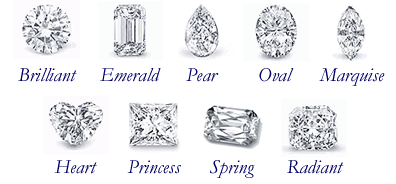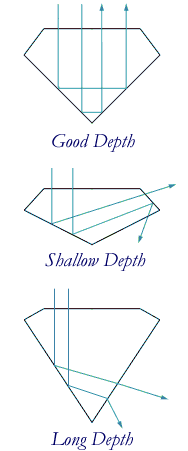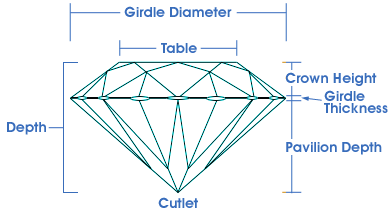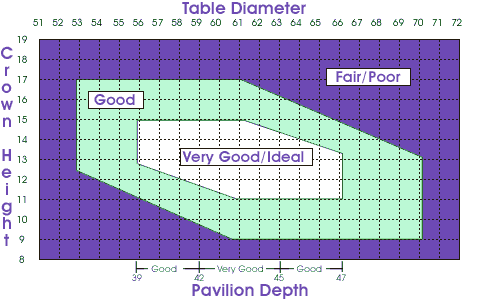|
Cut
To achieve maximum brilliance and shine, a diamond must be cut by a master of physico-optical laws. Every angle and plane must be precisely planned, calculated and measured. The cut is what allows light to enter and be reflected back out of the diamond.
Common Diamond Shapest

When choosing which shape is right for you, there is no rule or guideline to follow. You must pick a shape that will best suit your size and shape. The cut of a diamond is graded on a scale ranging from Ideal to Poor. The following is an explanation of each grade:
Cut Grading System
 |
Ideal Cut - Diamonds with this grade reflect
back the maximum amout of light possible. In order to do this, the
diamond must have complete symmetry. Round diamonds are the only
diamonds capable of having complete symmetry, and therefore, only
round diamonds may have an ideal cut grade.
Very Good Cut - The unaided eye cannot see the
difference between an ideal cut diamond and a very good cut diamond.
Almost all of the light that enters a very good cut diamond is reflected
back. And, as stated above, only round diamonds can receive an ideal
cut grade. Therefore, very good cut is the best grade that any other
diamond shape can receive. A round diamond with a very good cut
is considered a better value than an ideal cut round diamond because
nearly all of the light is reflected back through the diamond while
the price is lower than the more expensive ideal cut.
Good Cut - A good cut diamond is also considered
a great value. It reflects a large percentage of the light that
enters it and is considered a well proportioned cut. A good cut
diamond is perfect if you want a nice looking diamond without the
high price.
Fair Cut - Diamonds that are not well proportioned
and reflect little light are considered fair cut diamonds. Often
a fair cut diamond has more carat weight but loses some of the refraction
and brilliance that make a diamond so special.
Poor Cut - A diamond with very little light
reflection is usually a poor cut diamond. These diamonds are either
cut so deep or so shallow that almost no light is reflected back
up through the diamond. A poor cut is not recommended for diamonds
in jewelry. |
How to Judge Cut
In order to evaluate a diamond's cut, you need to know the different parts of a diamond:
 |
When looking at a diamond from the side view, you should be able to see if the pavilion is too shallow or deep, if the crown is too thick or thin, if the girdle is to thick or thin, and/or if the diamond is too long or flat. When examining the stone, you should measure the pavilion depth and girdle thickness. Then divide the pavilion by the girdle diameter. The GIA has suggested that the depth should be around 55 to 65% of the girdle diameter. And the pavilion depth should be between 2 1/2 and 3 1/2 times as long as the crown height. The table below shows what the ratios and proportions are for each grade of cut.
|

Various Cutting Styles
While there are many different styles of cuts, the GIA categorizes all of the styles into three basic types:
- Brilliant Cut - The brilliant cut has facets that are kite- or triangular-shaped. The facets radiate outward around the diamond. The round brilliant, oval, heart, pear, and marquise all use this style of cut. The "old mine" cut, the old European cut, and the singe cut are modifications of the brilliant cut. The old European and the old mine cut have 58 facets, a small table, large cutlet, and a high crown. These two cuts used to be polished and cut by hand and are often thought of as antiques. The old European cut is round whereas the old mine cut is squarish. The single cut is generally used for very small diamonds, as it has only 17 or 18 facets.
- Step Cut - As the name implies, the step cut has rows of facets that are cut in a step-like manner. They are usually elongated and four-sided. The emerald and baguette cuts are examples of the step cut, and the term "emerald cut" is even used when talking about step cuts.
- Mixed Cut - The mixed cut is a mixture of both the brilliant and step cuts. This cut used more often on colored gemstones than on diamonds.
|